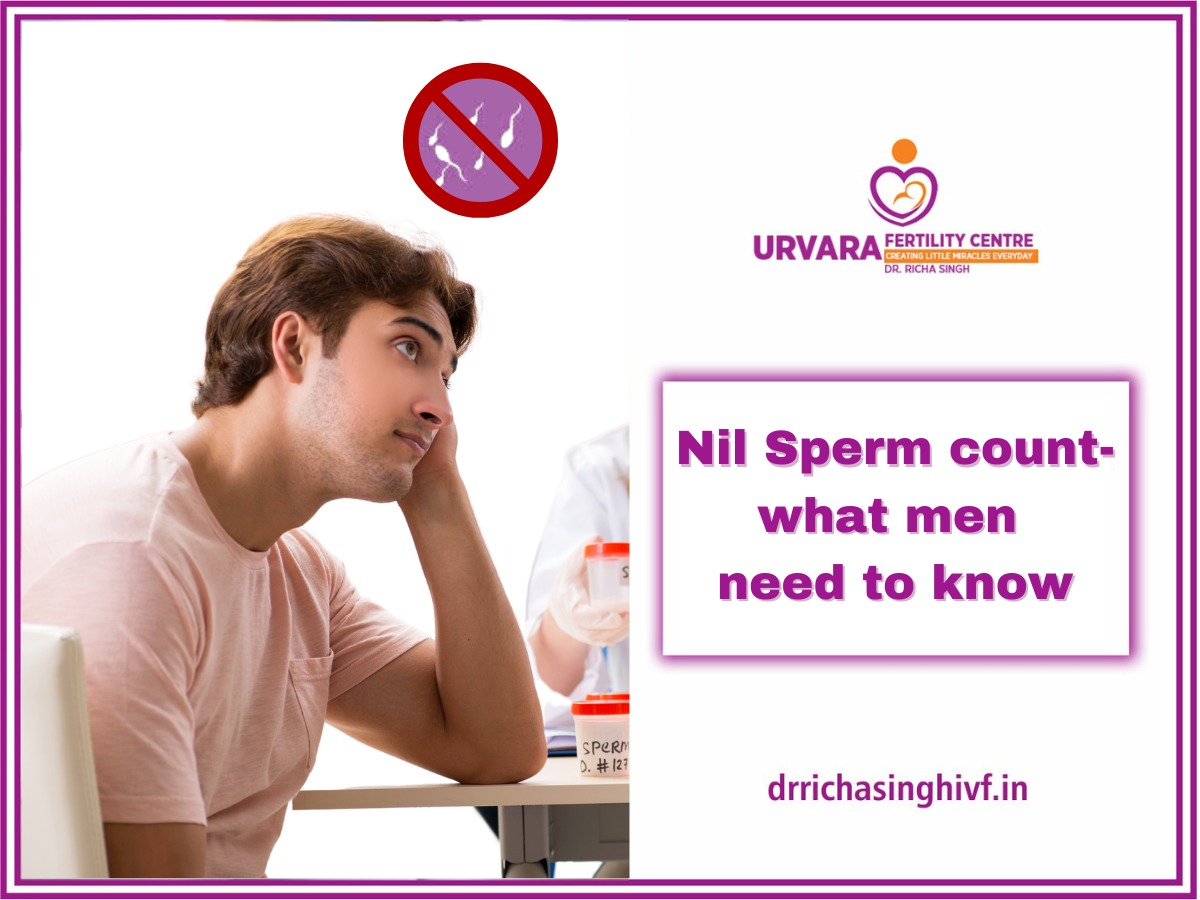Nil Sperm Count - What Men Need To Know
Nil sperm count is a condition that affects male fertility and can be a major cause of infertility. It refers to the absence of spermatozoa in the semen, also known as azoospermia. While it can be caused by various factors, it can be hard to diagnose and treat. In this blog post, we will discuss the causes, symptoms, diagnosis, and treatment of nil sperm count, as well as lifestyle changes that can help improve fertility.
Understanding Nil Sperm Count
Nil sperm count, also known as azoospermia, refers to the complete absence of spermatozoa in the semen. It is a major cause of male infertility and can occur due to obstructive or non-obstructive reasons.
Obstructive azoospermia occurs due to blockages in the reproductive tract, such as vasectomy, congenital absence of the vas deferens, or a blocked ejaculatory duct. On the other hand, non-obstructive azoospermia occurs due to a problem in sperm production or maturation, such as hormonal imbalances, genetic abnormalities, or certain medications.
In some cases, the cause of nil sperm count is unknown, and further testing may be required to determine the underlying cause.
Causes of Nil Sperm Count
There are various causes of nil sperm count, which can be broadly classified into obstructive and non-obstructive causes.
Obstructive Causes
1. Vasectomy: This is a surgical procedure in which the vas deferens, the tube that carries sperm from the testicles to the urethra, is cut or blocked to achieve contraception. While this procedure is usually reversible, it can lead to permanent infertility in some men.
2. Congenital absence of the vas deferens (CAVD): Some men are born without a vas deferens, which can prevent the release of sperm into the semen.
3. Blockages: These can occur due to infections, injuries, or inflammation. They can prevent the sperm from passing through the reproductive tract and being released in the semen.
Non-Obstructive Causes
1. Hormonal imbalances: Hormonal imbalances can affect the production of sperm and lead to nil sperm count.
2. Genetic abnormalities: Certain genetic conditions, such as Klinefelter syndrome, can cause abnormal development of the testicles and lead to nil sperm count.
3. Medications: Certain medications, such as chemotherapy drugs, can affect sperm production and cause nil sperm count.
In some cases, the cause of nil sperm count may be unknown.
Symptoms of Nil Sperm Count
The main symptom of nil sperm count is the inability to conceive after a year of unprotected sex. However, there are other symptoms that may be present:
- Erectile dysfunction
- Decreased libido
- Testicular pain
It's important to keep in mind that some men with nil sperm count may not experience any symptoms at all. That's why getting a proper diagnosis is crucial. If you're experiencing any of the symptoms listed above, or if you and your partner have been trying to conceive for over a year without success, it's time to seek medical attention.
Diagnosing Nil Sperm Count
The diagnosis of nil sperm count involves a semen analysis to determine the presence or absence of spermatozoa. This test involves collecting a semen sample, typically through masturbation, and examining it under a microscope. If no sperm are detected, it is considered a nil sperm count.However there needs to be minimum 3 reports of nil sperm counts at a time difference to confirm the diagnosis.Additional testing may be necessary to determine the underlying cause of nil sperm count. Blood tests may be performed to check for hormonal imbalances and genetic testing may be done to look for genetic abnormalities that could be causing the problem. In some cases, a testicular biopsy may be performed to get a closer look at the testicles.
A thorough medical history and physical examination are also important in diagnosing nil sperm count. Your healthcare provider will ask questions about your medical history, sexual history, and any current medications or treatments you are undergoing. They will also perform a physical exam to evaluate the health of your reproductive organs and look for any signs of abnormalities or blockages.
Overall, the diagnosis of nil sperm count requires a comprehensive evaluation to determine the underlying cause and develop an appropriate treatment plan. It is important to consult with a healthcare provider who specializes in male infertility to ensure the most effective management of the condition.
Treatment Options for Nil Sperm Count
Treatment options for nil sperm count will depend on the underlying cause. Here are some possible treatments:
Surgical Procedures:
If the cause of nil sperm count is obstructive, surgical procedures may be considered:
Vasectomy reversal: This procedure reconnects the vas deferens that was cut during a vasectomy.
Epididymal or testicular sperm extraction: If there is a blockage preventing sperm from reaching the semen, this procedure can extract sperm directly from the testicles or epididymis through aspiration by a syringe.
Hormone Replacement Therapy
If the cause of nil sperm count is a hormonal imbalance, hormone replacement therapy may be recommended:Testosterone replacement therapy: This can help boost sperm production if low testosterone levels are the cause of the sperm count problem.
Gonadotropin therapy: This involves injections of follicle-stimulating hormone (FSH) and luteinizing hormone (LH) to stimulate sperm production.
Assisted Reproductive Technologies
If other treatments are unsuccessful or not an option, assisted reproductive technologies (ART) can help couples conceive. Here are some examples:
In vitro fertilization (IVF): This involves fertilizing the egg with sperm outside the body and then transferring the embryo into the uterus.
Intracytoplasmic sperm injection (ICSI): This involves injecting a single sperm into the egg to fertilize it, which can be particularly helpful in cases where there are few sperm present.
It's important to discuss these treatment options with a healthcare provider to determine the best course of action based on individual circumstances and preferences.
Lifestyle Changes to Improve Fertility
There are several lifestyle changes that men can make to improve their fertility and increase their chances of conceiving. These include:
Quitting smoking: Smoking can decrease sperm count and motility. Quitting smoking can improve fertility.
Reducing alcohol consumption: Excessive alcohol consumption can also negatively impact sperm count and quality. Reducing alcohol intake may help improve fertility.
Maintaining a healthy weight: Being overweight or underweight can affect hormone levels and decrease fertility. Maintaining a healthy weight can help improve fertility.
Exercising regularly: Regular exercise can improve overall health and fertility. However, excessive exercise can have a negative impact on fertility, so it's important to maintain a healthy balance.
Reducing stress: Chronic stress can interfere with hormones that regulate fertility. Reducing stress through relaxation techniques or therapy may help improve fertility.
Avoiding exposure to toxins: Exposure to chemicals and toxins in the workplace or environment can negatively impact fertility. Taking steps to minimize exposure to these toxins can help improve fertility.
Maintaining good reproductive health: Practicing good hygiene and safe sex practices can help prevent infections that can negatively impact fertility. Regular check-ups with a healthcare provider can also help identify and address any potential reproductive health issues.
By making these lifestyle changes, men can improve their overall health and increase their chances of conceiving, even in cases of nil sperm count.
Conclusion
Nil sperm count can be a challenging issue for men who wish to start a family. However, with proper diagnosis and treatment, many underlying causes can be addressed. It's essential to maintain good reproductive health and make lifestyle changes that support fertility. If you're experiencing symptoms of nil sperm count, speak with your healthcare provider to determine the best course of action for your individual situation.

